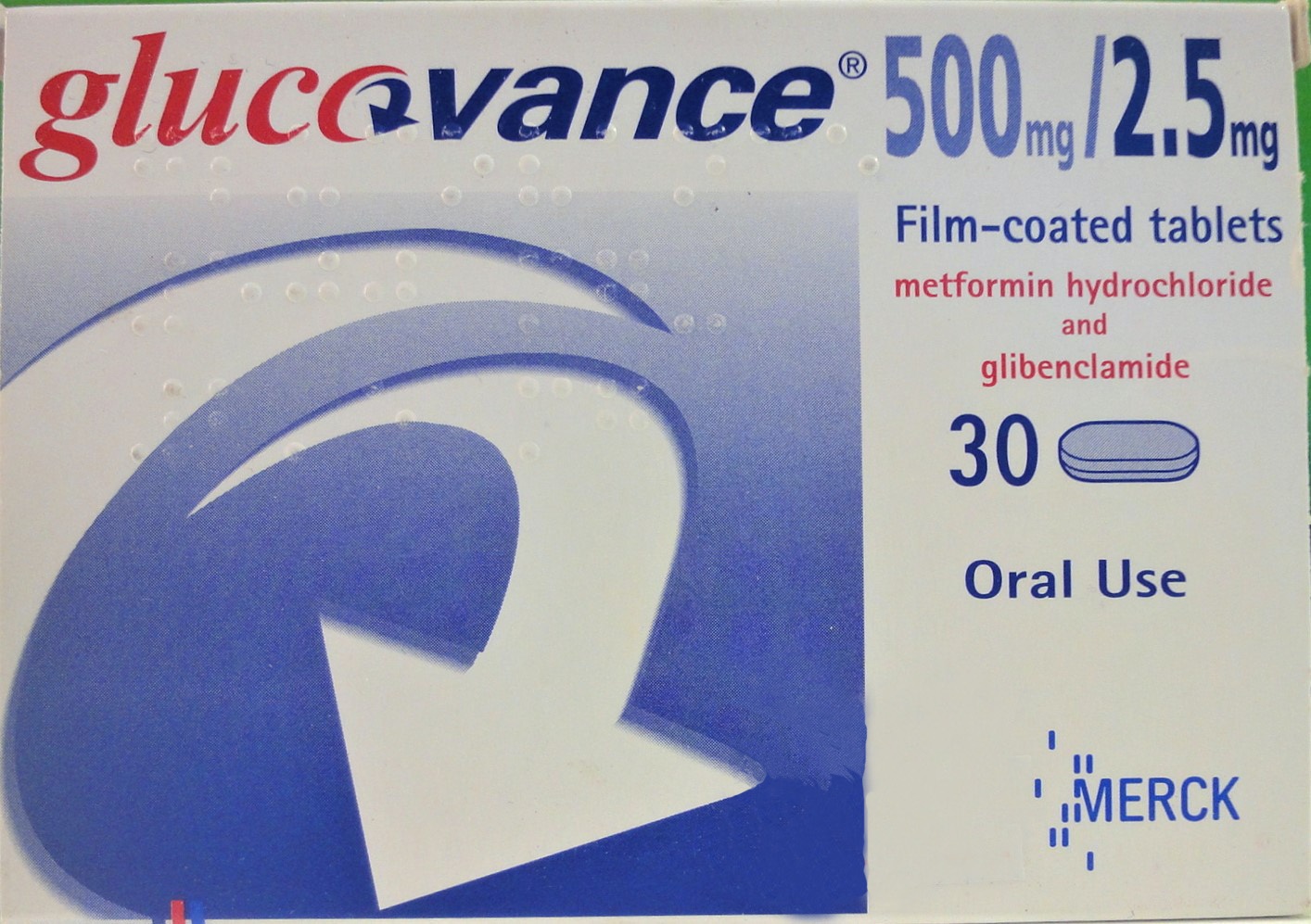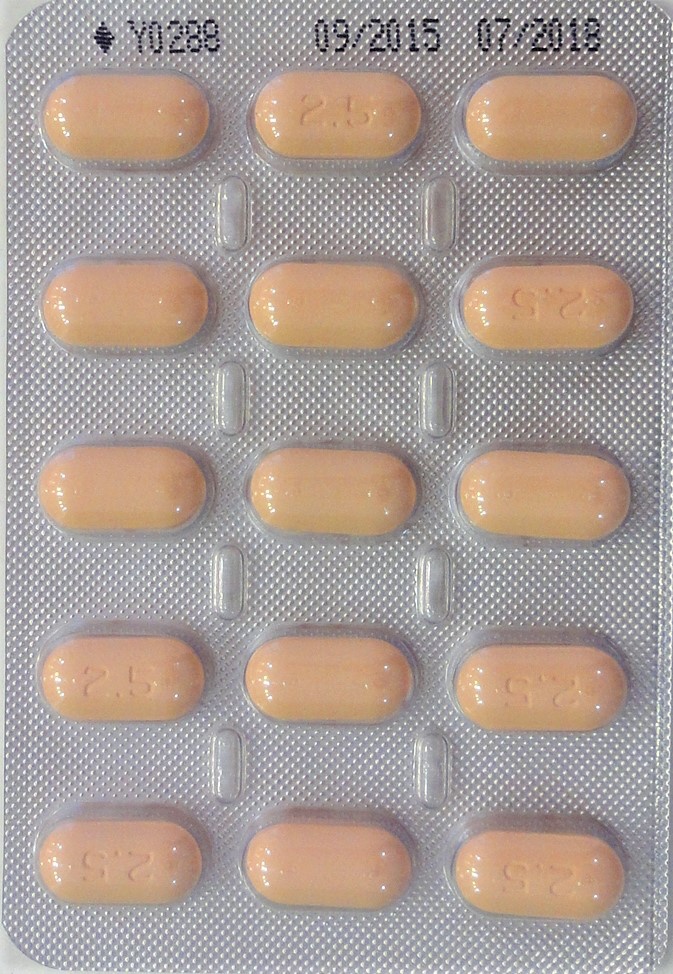GLUCOVANCE Tablet
ក្រុមហ៊ុនផលិតឱសថ:
Merck Sante, France
ក្រុមហ៊ុនចែកចាយឱសថនៅប្រទេសកម្ពុជា:
DKSH


- សារធាតុសកម្ម
- ប្រសិទ្ធិភាពព្យាបាល និង កម្រិតប្រើប្រាស់
- ហាមប្រើ
- ផលរំខាន
- អន្តរប្រតិកម្ម
- ស្ត្រីមានផ្ទៃពោះ និង ស្ត្រីបំបៅដោះកូន
- ការប្រុងប្រយ័ត្នជាពិសេស
- សកម្មភាពឱសថ បរិយាយប័ណ្ណឱសថ
-
សារធាតុសកម្ម
1. GLUCOVANCE 500mg/2.5mg:
Metformin hydrochloride 500mg, Glibenclamide 2.5mg
2. GLUCOVANCE 500mg/5mg:
Metformin hydrochloride 500mg, Glibenclamide 5mg
-
ប្រសិទ្ធិភាពព្យាបាល និង កម្រិតប្រើប្រាស់
គុណភាពព្យាបាល៖
- សម្រាប់ព្យាបាលជំងឺទឹកនោមផ្អែមប្រភេទ២ ចំពោះមនុស្សពេញវ័យដែលប្រើជំនួសការព្យាបាលកន្លងមកដោយ Metformin Glibenclamide ចំពោះអ្នកជំងឺដែលមានលំនឹងជាតិស្ករ។
កម្រិត និងរបៀបប្រើ៖ មុនប្រើឱសថនេះត្រូវពិគ្រោះជាមួយគ្រូពេទ្យ ហើយប្រើបានតែចំពោះមនុស្សពេញវ័យតែប៉ុណ្ណោះ
- កម្រិតប្រើដំបូង៖ មិនត្រូវប្រើលើសកម្រិតប្រចាំថ្ងៃនៃ Glibenclamide និង Metformin ដែលកំពុងប្រើទេ
- កម្រិតប្រើដោយកំណត់ (Titration): កម្រិតប្រើប្រចាំថ្ងៃអាចត្រូវបានតាមដានរាល់ 2អាទិត្យ ឬលើសពីនេះក្នុងការបន្ថែមមិនឱ្យលើសពី 500ម.ក្រ/5ម.ក្រ រហូតដល់កម្រិតដែលមានប្រសិទ្ធភាពខ្ពស់បំផុត។ គ្រូពេទ្យនឹងកំណត់កម្រិតប្រើដោយអាស្រ័យលើកម្រិតជាតិស្ករស្ករក្នុងឈាម និង HbA1c
- កម្រិតខ្ពស់បំផុត៖ 2000ម.ក្រ/20ម.ក្រ ក្នុង 1ថ្ងៃ ពេលបរិភោគអាហារ (4គ្រាប់នៃ Glucovance 500mg/5mg)
- មនុស្សចាស់ជរា៖ កម្រិតចាប់ផ្តើមគឺ 1គ្រាប់ (500ម.ក្រ/2,5ម.ក្រ) ក្នុង 1ថ្ងៃពេលបរិភោគអាហារ។
- កម្រិតប្រើត្រូវអាស្រ័យលើមុខងារតម្រងនោម
- ការតមអាហារត្រូវកម្រិតតាមទំលាប់់បរិភោគរបស់អ្នកជំងឺម្នាក់ៗ។ អាហារត្រូវមានជាតិ Carbohydrate ខ្ពស់គ្រាប់គ្រាន់ដើម្បីការពារនូវការថយចុះជាតិស្ករក្នុងឈាមត្រូវជៀសវាងប្រើជាតិអាល់កុលក្នុងពេលប្រើឱសថនេះ
- លេប 1គ្រាប់ក្នុង1ថ្ងៃពេលអាហារពេលព្រឹក បើអ្នកជំងឺត្រូវលេប1គ្រាប់ក្នុង1ថ្ងៃ។
- លេប 2ដងក្នុង1ថ្ងៃ ពេលអាហារពេលព្រឹក និងល្ងាច បើអ្នកជំងឺត្រូវលេប 2គ្រាប់ឬ 4គ្រាប់ក្នុង1ថ្ងៃ។
- លេប 3ដងក្នុង1ថ្ងៃ ពេលអាហារពេលព្រឹក ថ្ងៃត្រង់ និងល្ងាច បើអ្នកជំងឺត្រូវលេប 3គ្រាប់ ក្នុង1ថ្ងៃ។
Indication
Treatment of type 2 diabetes in adults as replacement for previous treatment with metformin and glibenclamide in patients whose glycaemia is stable and well controlled.
Dosage
This medicine is for adults only.
Initial treatment: The starting dose should not exceed the daily dose of glibenclamide and metformin already being taken.
Titration: The daily dose may be titrated every 2 weeks or longer in increments of no more than 500mg/5mg up to the minimum effective dose.
Maximum Dose: 2000mg/20mg/day.
Elderly subjects: The initial dosage is 500mg/2.5mg daily. The dosage should then be adjusted depending on renal function parameters.
Administration: The tablets should be taken with meals. The dosage regimen should be adjusted according to the individual eating habits. However, any intake must be followed by a meal with a sufficiently high carbohydrate content to prevent hypoglycaemia. Patients should avoid alcohol when taking this medicine. Take the tablets:
- once a day, in the morning (breakfast) if you take 1 tablet per day,
- twice a day, in the morning (breakfast) and evening (dinner) if you take 2 or 4 tablets per day,
- three times a day, in the morning (breakfast), noon (lunch) and evening (dinner), if you take 3 tablets per day.
Missed dose: You must not take a double dose to make up for a forgotten dose. You should take the next dose at the usual time.
-
ហាមប្រើ
ហាមប្រើចំពោះ៖
- អ្នកមានប្រតិកម្មអាល្លែកហ្ស៊ីជាមួយសារធាតុផ្សំណាមួយនៃឱសថនេះ ឬពួក Sulfonamide ដទៃទៀត។
- អ្នកជំងឺទឹកនោមផ្អែមប្រភេទ1 (ត្រូវប្រើ Insulin) ឬអ្នកជំងឺទឹកនោមផ្អែមធ្ងន់ធ្ងរមិនបានតាមដាន ឬមានជាតិសេតូនក្នុងជាលិកាកើនឡើង (Precoma)។
- អ្នកជំងឺខ្សោយតម្រងនោម (Creatinine Clearance<60ml/mn
- អ្នកមានជំងឺឆ្លងធ្ងន់ធ្ងរ
- អ្នកបាត់ជាតិទឹក (ពេលរាកធ្ងន់ធ្ងរ និងក្អួតខ្លាំង)
- អ្នកធ្លាប់ព្យាបាលជំងឺបេះដូង អ្នកមានជំងឺស្លោកសាច់ដុំបេះដូង ឬមានវិបត្តិចរន្តឈាមធ្ងន់ធ្ងរ និងពិបាកដកដង្ហើម
- អ្នកមានជមង
- you are allergic (hypersensitive) to metformin hydrochloride, glibenclamide or other sulphonamides or any of the other ingredients of this drug.
- you suffer from type 1 diabetes mellitus (i.e. insulin-dependent) or if you have severe loss of diabetes control with either pre-coma or ketosis (a condition caused by substances called “ketone bodies” accumulating in the blood: you may notice that your breath has an unusual, fruity odor),
- you have kidney insufficiency (creatinine clearance <60ml/min) or liver insufficiency,
- you have a severe infection (for example an infection of the air passages or an urinary tract infection),
- you are dehydrated (for example due to persistent or severe diarrhoea, recurrent vomiting),
- you are treated for heart problems, have recently had a myocardial infarction, have severe circulatory problems or breathing difficulties,
- you suffer from porphyria (a rate, hereditary disease due to an enzyme deficiency causing the body to produce and excrete too much porphyrin, a component used to make the part of blood pigment that carries oxygen),
- you need to have an X-ray examination involving the injection of an iodinated contrast medicine into the bloodstream. You must stop taking this medicine prior to, or not later than at the time of the test. You must take this medicine until 48 hours afterwards, and only after the kidney function has been tested and found normal,
- you use miconazole even for local use,
- you drink alcohol excessively (either every day or only from time to time),
- you are breast-feeding.
-
ផលរំខាន
ផលរំខានខ្លះៗ៖
- វិបត្តិគំហើញ កម្រិតជាតិស្ករក្នុងឈាមទាប អ្នកមានវិបត្តិជាតិអាស៊ីត Lactic វិបត្តិក្រពះ ពោះវៀនដូចជា ចង្អោរ ក្អួត រាក ឈឺពោះ មិនឃ្លានអាហារ វិបត្តិស្បែកដូចជា៖ រមាស់ កន្ទាលត្រអាក កន្ទួលក្រហមលើស្បែក ប្រតិកម្មអាល្លែកហ្ស៊ី របកស្បែក រលាកស្បែក ប្រតិកម្មដោយពន្លឺថ្ងៃ បើរោគសញ្ញាទាំងនេះមិនបាត់ត្រូវបញ្ឈប់ការប្រើឱសថនេះ បើមានរលាកថ្លើមលទ្ធផលតេស្តមុខងារថ្លើមប្រែប្រួល
- វិបត្តិថ្លើម និងស្បែកពីកំណើត (Hepatic porphyria និង Porphyria cutanea)
- វិបត្តិការដឹងរសជាតិ
- វិបត្តិគ្រាប់ឈាម៖
+ ចំនួនកោសិកាឈាមស និងប្លាកែតចុះ ជំងឺកង្វះគ្រាប់ឈាមក្រហម វិបត្តិការផលិតគ្រាប់ឈាម (bone marrow aplasia) និងចំនួនគ្រាប់ឈាមគ្រប់ប្រភេទ ថយចុះផលរំខានទាំងនេះនឹងត្រឡប់មកធម្មតាវិញ នៅពេលបញ្ឈប់ការព្យាបាលដោយឱសថនេះ
+ ការជ្រាបចូលវីតាមីន B12 ថយចុះហេតុនេះត្រូវគិតពីភាពស្លេកស្លាំងដែលបណ្តាលពីកង្វះវីតាមីន B12
+ កម្រិតជាតិ សូដ្យូមក្នុងឈាមចុះទាប
- Transient visual disturbances at the start of treatment due to a decrease in glycaemia levels.
- Hypoglycaemia.
- Lactic acidosis.
- Gastrointestinal disorders such as nausea, vomiting, diarrhoea, abdominal pain and loss of appetite. These adverse effects occur more frequently during treatment initiation and resolve spontaneously in most cases. A slow increase of the dose may also improve gastrointestinal tolerability. Should these symptoms continue, STOP taking this medicine and CONSULT your DOCTOR.
- Pruritus, urticaria, maculopapular rash, cutaneous or visceral allergic angiitis, erythema multiforme, exfoliative, dermatitis, photosensitization, urticaria evolving to shock. A cross reactivity to sulphenamide(s) and their derivatives may occur.
- Liver function test abnormalities or hepatitis requiring treatment discontinuation.
- Crises of hepatic porphyria and porphyria cutanea.
- Disulfiram-like reaction with alcohol intake.
- Taste disturbance.
- Leucopoenia, thrombocytopenia, agranulocytosis, haemolytic anaemia, bone marrow aplasia and pancytopenia. These are reversible upon treatment discontinuation.
- Decrease of vitaminB12 absorption with decrease of serum levels during long-term use of metformin. Consideration of such aetiology is recommended if you present with megaloblastic anaemia.
- Average to moderate elevations in serum urea and creatinine concentrations.
- Hyponatremia.
-
អន្តរប្រតិកម្ម
ត្រូវប្រុងប្រយ័ត្ននៅពេលប្រើឱសថនេះក្នុងពេលតែមួយជាមួយ៖
- ពួក Angiotensin-converting enzyme inhibitors ព្រោះវាអាចធ្វើឱ្យកើនឡើងប្រសិទ្ធភាពបញ្ចុះជាតិស្ករក្នុងឈាមរបស់ Glibenclamide
- ពួក Diuretics ព្រោះវាអាចបង្កើនគ្រោះថ្នាក់ដោយជាតិ Lactic acid ករណីនេះត្រូវតាមដានមុខងារតម្រងនោម
- ពួក Beta-blockers ព្រោះវាអាចបង្កើនគ្រោះថ្នាក់ធ្ងន់ធ្ងរដោយសារការថយចុះជាតិស្ករក្នុងឈាម
- ពួក Beta 2 agonists for corticosteroid និង Tetracosactide ព្រោះវាធ្វើឱ្យកើនឡើងកម្រិតជាតិស្ករក្នុងឈាម។
- Phenylbutazone ព្រោះវាបង្កើនប្រសិទ្ធភាពបញ្ចុះជាតិស្ករក្នុងឈាមនៃ Glibenclamide
- Fluconazole បង្កើនគ្រោះថា្នក់នៃការថយចុះជាតិស្ករក្នុងឈាម
- Chlorpromazine និង Danazole អាចបង្កើនកម្រិតជាតិស្ករក្នុងឈាម
- Desmopressin អាចធ្វើឱ្យថយចុះប្រសិទ្ធភាព Antidiuretic របស់ Desmopressin
- ជៀសវាងប្រើជាតិអាល់កុល និងឱសថដែលមានជាតិអាល់កុល
- ត្រូវជម្រាបគ្រូពេទ្យ ឬឱសថការីបើមានប្រើឱសថដទៃទៀត
While taking this medicine, you must not use any of the following medicines;
- Miconazole even for local use.
- Iodinated contrast agents.
Special precautions may be required if you take this medicine and any of the following medicines at the same time; (see the package insert about the details)
- Angiotensin-converting enzyme inhibitors
- Diuretics (loop diuretics specially
- Beta-blockers
- Beta-2 agonists
- Corticosteroids and tetracosactide
- Fluconazole
- Chlorpromazine
- Danazol
- Desmopressin
Avoid alcohol and medicines containing alcohol
-
ស្ត្រីមានផ្ទៃពោះ និង ស្ត្រីបំបៅដោះកូន
ស្ត្រីមានផ្ទៃពោះ និងស្ត្រីបំបៅកូន មុនប្រើឱសថនេះត្រូវពិគ្រោះជាមួយគ្រូពេទ្យ។
- Tell your doctor if you are, you think you might be or are planning to become pregnant. During pregnancy, diabetes should be treated with insulin. If you find out that you are pregnant while taking this medicine. consult your doctor so that he/she may change your treatment.
- You must not take this medicine, if you are breast-feeding or if you are planning to breast-feed your baby.
-
ការប្រុងប្រយ័ត្នជាពិសេស
- ឱសថនេះត្រូវប្រើដោយគ្រូពេទ្យឯកទេស
- អ្នកមានវិបត្តិជាតិ Lactic acid (Lactic acidosis): ត្រូវបញ្ឈប់ការប្រើឱសថនេះភ្លាម និងជម្រាបគ្រូពេទ្យបើអ្នកធ្លាប់មានរោគសញ្ញាដូចជា៖ ក្អួត ឈឺក្បាលពោះ ដោយរមួលសាច់ដុំ មានអារម្មណ៍មិនស្រួលខ្លួន មានអារម្មណ៍ឃ្លាន ព្រិលភ្នែក ងងុយដេក អស់កម្លាំង និងខ្សោយខុសប្រក្រតី រោគសរសៃប្រសាទ ឬញ័រ ថប់អារម្មណ៍ ភាន់ភាំង អារម្មណ៍មិននឹងនរ បើមានរោគសញ្ញាទាំងនេះដំបូងត្រូវបរិភោគស្ករ ឬអាហារដែលមានជាតិស្ករច្រើន បន្ទាប់មកត្រូវសម្រាក និងបញ្ឈប់ការប្រើ ឱសថនេះភ្លាមរួចប្រាប់គ្រូពេទ្យ
- អ្នកជំងឺត្រូវតាមដាន និងពិនិត្យជាតិស្ករក្នុងឈាមឱ្យបានទៀងទាត់
- កម្រិតជាតិស្ករក្នុងឈាមទាបអាចកើនឡើងបើ៖
+ អ្នកបរិភោគតិចពេក ឬមិនបានបរិភោគ ឬបរិភោគអាហារដែលមានជាតិស្ករមិនគ្រប់គ្រាន់
+ អ្នកផឹកគ្រឿងស្រវឹង (Alcohol)
+ អ្នកធ្វើលំហាត់ប្រាណហួសកំណត់
+ អ្នកមានបញ្ហាថ្លើម តម្រងនោម ឬអរម៉ូន
+ កម្រិតនៃឱសថនេះខ្ពស់ពេក (បើប្រើលើសកម្រិត)
+ អ្នកជាមនុស្សចាស់ជរា
+ អ្នកប្រើឱសថដទៃទៀតជាមួយឱសថនេះ ក្នុងពេលតែមួយ
- ជំងឺឆ្លង៖ ត្រូវប្រាប់ទៅគ្រូពេទ្យបើអ្នកត្រូវវះកាត់ដោយប្រើពួក Anesthesia
- ជាតិ Lactose: មុនប្រើឱសថនេះ ត្រូវពិគ្រោះជាមួយគ្រូពេទ្យព្រោះឱសថនេះមានជាតិស្ករ
- ការណែនាំផ្សេងទៀត៖ ត្រូវគោរពតាមដំបូន្មានគ្រូពេទ្យគឺត្រូវតមអាហារបើអ្នកលើសទម្ងន់ និងត្រូវធ្វើលំហាត់ប្រាណឱ្យបានទៀងទាត់។ ត្រូវពិគ្រោះជាមួយគ្រូពេទ្យ ឱ្យបានទៀងទាត់ដើម្បីធ្វើតេស្តរកកម្រិតជាតិស្ករក្នុងឈាម និងមុខងារតម្រងនោម
Lactic acidosis: Take special care with this medicine if you experience symptoms such as vomiting, bellyache with muscle cramps and a general feeling of discomfort with severe fatigue and difficulty in breathing.
Lactic acidosis is a medical emergency that can occur due to metformin accumulation, especially in diabetic patients with significant renal failure. Other associated risk factors are poorly controlled diabetes, ketosis, prolonged fasting, alcoholism, liver insufficiency and any condition associated with hypoxia.
Hypoglycaemia: Take special care with this medicine if you experience some symptoms of hypoglycaemia. The warning signs may occur suddenly and can include cold sweat, cold and pale skin, dizziness, headache, rapid heartbeat, feeling sick, feeling very hungry, temporary changes in vision, drowsiness, unusual tiredness and weakness, nervousness or tremor, feeling anxious, feeling confused, difficulty in concentrating. If you notice any of these signs: first eat glucose tablets or a high sugar snack (honey, sugar), then rest. STOP taking this medicine immediately and tell your doctor straight away as you may need to be hospitalized to bring your blood glucose back under control.
A hypoglycaemia may occur if : see the package insert.
Infectious diseases: Inform your doctor if you suffer from any infectious illness such as flu, infection of the air passages or urinary tract infection.
Surgical procedures: Inform your doctor if you are going to have an operation or any examination under anaesthesia as you may need to stop taking this medicine for a couple of days before and after the procedure.
Lactose: Each Glucovance tablet contains lactose. If your doctor has told you that you have intolerance to certain sugars (galactosaemia, glucose and galactose malabsorption syndrome or lactase deficiency), contact your doctor before taking this medicine.
Further monitoring recommendations: Continue to follow any dietary advice your doctor has given you including some energy-restricted diet if you are overweight. Get some regular exercise while you are taking this medicine.
Consult your doctor regularly to test your blood sugar levels and your kidney function, if any of the above-mentioned situations applies to you or if you feel unsure about using this medicine.
Effects on the Ability to Drive and Use Machines: Do not drive or use machines:
- if your vision is blurred. This may happen at the beginning of the treatment because of a lower level of sugar in your blood.
- if you feel that symptoms of hypoglycaemia sugar begin to appear.
Reconsider your ability to drive or use machines in case you have reduced or absent awareness of the warning signs of hypoglycaemia or have frequent episodes of hypoglycaemia.
-
សកម្មភាពឱសថ
ឱសថនេះផ្សំពីសារធាតុសកម្មចំនួនពីរ សម្រាប់ព្យាបាលជំងឺទឹកនោមផ្អែមគឺ Metformin ស្ថិតក្នុងក្រុម Biguanide មានប្រសិទ្ធភាពកាត់បន្ថយការផលិតជាតិស្ករក្នុងថ្លើមដោយបង្កើនប្រសិទ្ធភាព Insulin ក្នុងសាច់ដុំ និងពន្យារការស្រូបចូលជាតិស្ករក្នុងពោះវៀនតូច ខណៈដែល Glibenclamide ជំរុញការបញ្ចេញ Insulin ដោយលំពែង។
Glucovance is made up of two antidiabetic medicines, which belong to the groups of medicines called biguanide (metformin hydrochloride) and sulphonylurea (glibenclamide). Metformin hydrochloride and glibenclamide have different mechanisms and sites of action, but their action is complementary. Metformin reduces hepatic glucose production, increases insulin sensitivity in muscle and delays intestinal glucose absorption while glibenclamide stimulates the release of insulin by the pancreas.
*ព័ត៌មានឱសថត្រូវបានរៀបរៀងដោយ អ៊ីម៉ាតុគឹ មេឌីក (ខេមបូឌា) ដោយផ្អែកលើប្រភពព័ត៌មានខាងក្រោម។ សម្រាប់ព័ត៌មានលម្អិត សូមស្វែងរកនៅក្នុងក្រដាសព័ត៌មាននៃឱសថនីមួយៗ ឬ សាកសួរទៅកាន់ក្រុមហ៊ុនឱសថឬតំណាងចែកចាយនៃឱសថនីមួយៗ។
ប្រភពព័ត៌មាន៖
- ក្រដាសព័ត៌មាននៃឱសថសម្រាប់អ្នកជំនាញវេជ្ជសាស្ត្រដែលប្រើប្រាស់នៅប្រទេសជប៉ុន (Pharmaceutical and Medical Devices Agency, Pmda): https://www.pmda.go.jp
- ព័ត៌មានសង្ខេបនៃឱសថសម្រាប់អ្នកជំងឺដែលប្រើប្រាស់នៅប្រទេសជប៉ុន: http://www.rad-ar.or.jp
